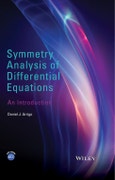A self-contained introduction to the methods and techniques of symmetry analysis used to solve ODEs and PDEs
Symmetry Analysis of Differential Equations: An Introduction presents an accessible approach to the uses of symmetry methods in solving both ordinary differential equations (ODEs) and partial differential equations (PDEs). Providing comprehensive coverage, the book fills a gap in the literature by discussing elementary symmetry concepts and invariance, including methods for reducing the complexity of ODEs and PDEs in an effort to solve the associated problems.
Thoroughly class-tested, the author presents classical methods in a systematic, logical, and well-balanced manner. As the book progresses, the chapters graduate from elementary symmetries and the invariance of algebraic equations, to ODEs and PDEs, followed by coverage of the nonclassical method and compatibility. Symmetry Analysis of Differential Equations: An Introduction also features:
- Detailed, step-by-step examples to guide readers through the methods of symmetry analysis
- End-of-chapter exercises, varying from elementary to advanced, with select solutions to aid in the calculation of the presented algorithmic methods
Symmetry Analysis of Differential Equations: An Introduction is an ideal textbook for upper-undergraduate and graduate-level courses in symmetry methods and applied mathematics. The book is also a useful reference for professionals in science, physics, and engineering, as well as anyone wishing to learn about the use of symmetry methods in solving differential equations.
Table of Contents
Preface xi
Acknowledgments xiii
1 An Introduction 1
1.1 What is a Symmetry? 1
1.2 Lie Groups 4
1.3 Invariance of Differential Equations 6
1.4 Some Ordinary Differential Equations 8
Exercises 12
2 Ordinary Differential Equations 15
2.1 Infinitesimal Transformations 19
2.2 Lie’s Invariance Condition 23
Exercises 27
2.3 Standard Integration Techniques 28
2.3.1 Linear Equations 28
2.3.2 Bernoulli Equation 30
2.3.3 Homogeneous Equations 31
2.3.4 Exact Equations 32
2.3.5 Riccati Equations 35
Exercises 37
2.4 Infinitesimal Operator and Higher Order Equations 38
2.4.1 The Infinitesimal Operator 38
2.4.2 The Extended Operator 39
2.4.3 Extension to Higher Orders 40
2.4.4 First-Order Infinitesimals (revisited) 40
2.4.5 Second-Order Infinitesimals 41
2.4.6 The Invariance of Second-Order Equations 42
2.4.7 Equations of arbitrary order 43
2.5 Second-Order Equations 43
Exercises 55
2.6 Higher Order Equations 56
Exercises 61
2.7 ODE Systems 61
2.7.1 First Order Systems 61
2.7.2 Higher Order Systems 67
Exercises 71
3 Partial Differential Equations 73
3.1 First-Order Equations 73
3.1.1 What Do We Do with the Symmetries of PDEs? 77
3.1.2 Direct Reductions 80
3.1.3 The Invariant Surface Condition 83
Exercises 84
3.2 Second-Order PDEs 84
3.2.1 Heat Equation 84
3.2.2 Laplace’s Equation 91
3.2.3 Burgers’ Equation and a Relative 94
3.2.4 Heat Equation with a Source 100
Exercises 107
3.3 Higher Order PDEs 109
Exercises 115
3.4 Systems of PDEs 115
3.4.1 First-Order Systems 115
3.4.2 Second-Order Systems 120
Exercises 124
3.5 Higher Dimensional PDEs 126
Exercises 132
4 Nonclassical Symmetries and Compatibility 133
4.1 Nonclassical Symmetries 133
4.1.1 Invariance of the Invariant Surface Condition 135
4.1.2 The Nonclassical Method 137
4.2 Nonclassical Symmetry Analysis and Compatibility 146
4.3 Beyond Symmetries Analysis–General Compatibility 147
4.3.1 Compatibility with First-Order PDEs–Charpit’s Method 149
4.3.2 Compatibility of Systems 157
4.3.3 Compatibility of the Nonlinear Heat Equation 159
Exercises 160
4.4 Concluding Remarks 161
Solutions 163
References 171
Index 175








